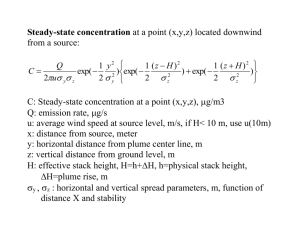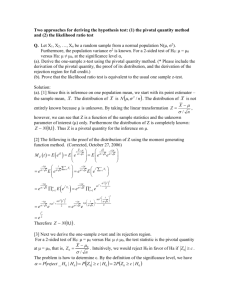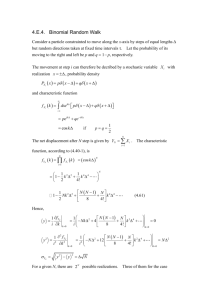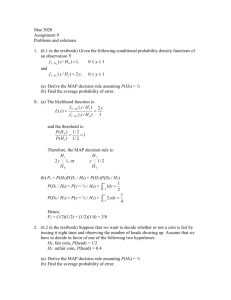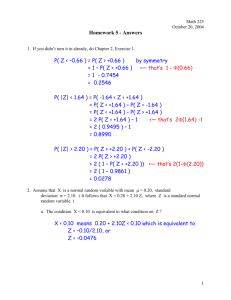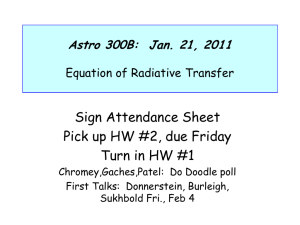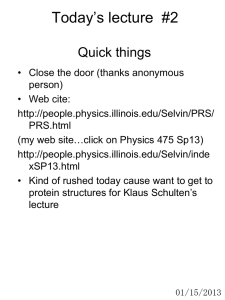Air - Civil and Environmental Engineering | SIU
advertisement
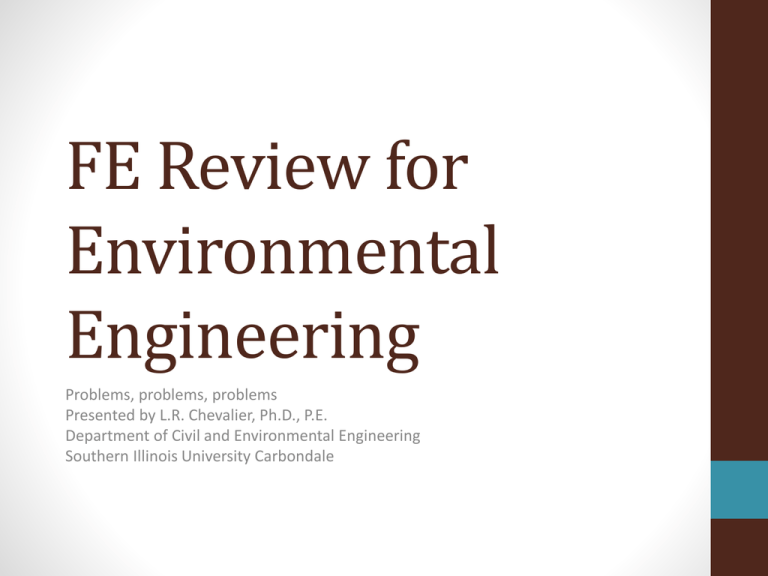
FE Review for Environmental Engineering Problems, problems, problems Presented by L.R. Chevalier, Ph.D., P.E. Department of Civil and Environmental Engineering Southern Illinois University Carbondale FE Review for Environmental Engineering AIR Problem Strategy Solution Estimate the amount of soda ash required per m3 of exhaust gas to neutralize 20,000 g/m3 of SO2 at 20° C. Problem Strategy Solution • Review governing reaction • Determine the mass of soda ash needed from mole ratio The neutralization reaction is: SO 2 Na 2 CO 3 Na 2 SO 3 CO MW: SO2 = 64 Na2CO3 = 106 2 The mass of soda ash is then: m Na 2 CO 3 106 g Na 2 CO 3 20 . 0 mg SO 2 64 g SO 2 33 . 125 mg Therefore, for each m3 of exhaust gas, we require 33.1 mg Na2CO3 Problem Strategy Solution Consider a box model for an air shed over a city 1 x 105 m wide with a mixing depth of 1200 m. Winds with no SO2 blow at 4 m/s against one side of the box. SO2 is emitted in the box at a rate of 20 kg/s. If SO2 is considered to be conservative, estimate the steady state concentration in the air shed. Report your answer in g/m3. Problem Strategy Solution • Draw a schematic of your system • Consider mass balance Solution L H = 1200 m wind u = 4 m/s Co = 0 g/m3 W = 1 x 105 m wind u = 4 m/s Ce =? Emission 20 kg/s Problem Strategy Solution L H = 1200 m wind u = 4 m/s Co = 0 g/m3 W = 1 x 105 m wind u = 4 m/s Ce =? Emission 20 kg/s Ce = Co +(qL)/(uH) L H = 1200 m wind u = 4 m/s Co = 0 g/m3 W = 1 x 105 m wind u = 4 m/s Ce =? Ce = Co +(qL)/(uH) Emission 20 kg/s Ce 20 kg s L LW 4 m s 1200 m 10 9 g kg 41 . 67 g m 3 Problem Strategy Solution Consider the emission of SO2 from a coal fired power plant, at a rate of 1,500 g/s. The wind speed is 4.0 m/s on a sunny afternoon. What is the centerline concentration of SO2 3 km downwind (Note: centerline implies y=0). Stack parameters: Height = 130 m Diameter = 1.5 m Exit velocity = 12 m/s Temperature = 320°C (593° K) Atmospheric conditions: P=100 kPa T=25° C (298° K) • Review data • Estimate effective stack height vs d H 1 . 5 u Ts Ta 2 2 . 68 10 P d Ts • Determine stability class • Calculate sy and sz • Review terms and apply governing equation C x , y ,0 , H Q exp s y s z u 2 1 y exp 2 s y 1 H 2 2 s z 12 m s 1 . 50 m 593 298 2 H 1 . 5 2 . 68 10 100 1 . 5 4 .0 m s 593 4 . 5 m 3 . 43 15 . 44 m H = effective stack height = h + H = 130 m + 15.4 m = 145.4 m Problem Strategy Solution Atmospheric stability class: Class B sy = ax0.894 = 156(3)0.894 = 416.6 m sz = cxd + f = 108.2(3)1.098 + 2 = 363.5 m 1 1 145 . 44 1500 C x, y, z, H exp 0 exp 416 . 6 363 . 5 4 . 0 2 363 . 5 4 exp 0 .08 4 0 .923 7 . 88 10 7 . 88 10 7 . 28 10 4 3 g m of SO 2 728 . 6 g m 3 2 Example Solution Simplify the Gaussian dispersion model to describe a ground level source with no thermal or momentum flux, which is the typical release that occurs at a hazardous waste sites. In this situation, the effective plume rise, H, is essentially 0. C x , y ,0 , H Q exp s y s z u 2 1 y exp 2 s y C x , y ,0 , H Q exp s y s z u 2 1 y exp 0 2 s y C x , y ,0 , H 2 Q 1 y exp s y s z u 2 s y 1 H 2 2 s z Problem Strategy Solution Consider soil under a single story house that emits 1.0 pCi/m2·s of radon gas. The house has 250 m2 of floor space, and average ceiling height of 2.6 m, and an air change rate of 0.9 ach. Estimate the steady state concentration of radon in the house, assuming that the ambient concentration is negligible. For radon, k = 7.6 x 10-3 hr-1 • Review data • Review SS equation Volume = (250 m2)(2.6 m) = 650 m3 Q/V = 0.9 Ventilation rate = Q = (650 m3)(0.9) = 585 m3/hr Ci = 0 E = (1.0 pCi/m2·s)(250 m2)(3600 s/hr) = 900000 pCi/hr Q Ce V Ci Q V E V k 90000 pCi hr 3 650 m Ce 1 0 . 9 hr 0 . 0076 hr 1525 pCi m 3 1



